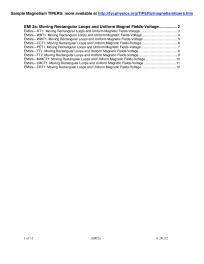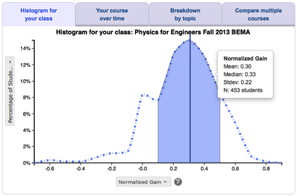
Developed by: Curtis Hieggelke, David Maloney, Stephen Kanim, Thomas O'Kuma




middle schoolhigh schoolintro collegeinter-mediateupper levelgrad school other

calc based

alg based

conceptual






Overview
What? Short activities that help students apply concepts and address known difficulties. Activities are designed so that they cannot be solved using "plug-and-chug."
Why? Because the tasks are short and independent of one another, they are easy to try out without making significant alterations to your course. They are constructed to be the right "step size" so that students feel comfortable responding to them using their natural ideas rather than memorized physics.
Why not? While the structure and content of TIPERs are based on physics education research and many are taken directly from the research literature, there is no research on the impact of the final collection of TIPERs on student learning. The books are published commercially so there is a cost for students.
Activity outline
Ten TIPER formats:
Bar Chart Tasks — these require student to draw histograms for specified quantities of a situation.
Changing Representation Tasks — given one representation, e.g., a free-body diagram, students generate an alternative representation, e.g., the Newton’s second law equation.
Comparison Tasks — these ask the student to determine which of two situations has a greater value for a quantity, or if the two situations have the same value for quantity.
Conflicting Contentions Tasks — these tasks present two or three (usually natural language) statements about a situation and the goal is to decide which, if any, of the statements is correct.
Linked Multiple-Choice Tasks — in these the same question, with the same set of answer possibilities, is asked about a sequence of variations for a situation.
Qualitative Reasoning Tasks — these tasks ask about how a qualitative variation of a situation affects the behavior of the system.
Ranking Tasks — ask students to rank a set of physical situations based on the magnitude of a single characteristic.
Troubleshooting Tasks — these require the identification of the acknowledged error(s) in a contention, representation or analysis.
What, if Anything, is Wrong Tasks — these are similar to troubleshooting tasks except that there may not be anything wrong.
Working Backwards Tasks — these usually have one or more equations as the starting point with the goal being a description or drawing of a physical situation.
Student skills developed
- Conceptual understanding
Instructor effort required
- Low
Resources required
- Cost for students
Resources
For suggestions about how to develop your own TIPERs, see Maloney, "Developing Conceptual Exercises", Winter 1994/95 CaFD Newsletter.
Teaching Materials
TIPERs are published in a series of books by Pearson (you can download the instructor's guide from the resources tab in each of the links below):
Research
This is the lowest level of research validation, corresponding to at least one of the validation categories below.
Research Validation Summary
Based on Research Into:
- theories of how students learn
- student ideas about specific topics
Demonstrated to Improve:
- conceptual understanding
- problem-solving skills
- lab skills
- beliefs and attitudes
- attendance
- retention of students
- success of underrepresented groups
- performance in subsequent classes
Studied using:
- cycle of research and redevelopment
- student interviews
- classroom observations
- analysis of written work
- research at multiple institutions
- research by multiple groups
- peer-reviewed publication
References
- G. C. Jacobs, Rank the voltage across light bulbs … then set up the live experiment, 56 (2) 120-121 (2018).
- D. Maloney, C. Hieggelke, and S. Kanim, nTIPERs: Tasks to Help Students “Unpack” Aspects of Newtonian Mechanics, presented at the Physics Education Research Conference 2010, Portland, Oregon, 2010.





